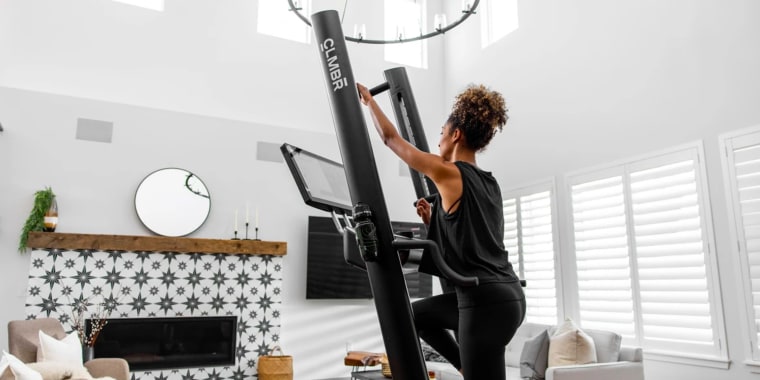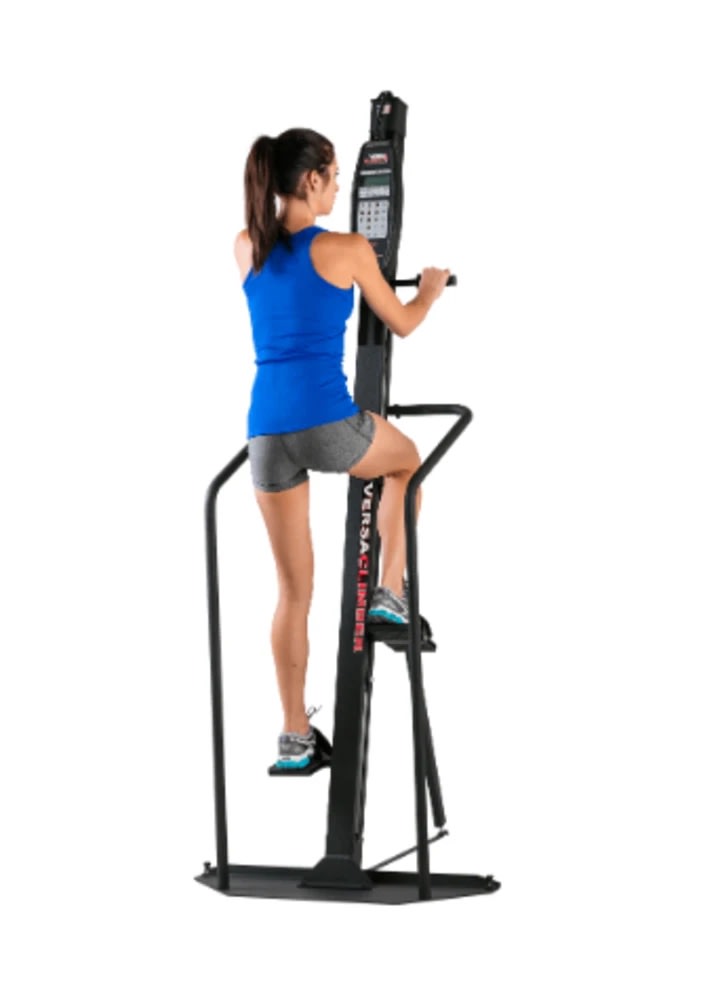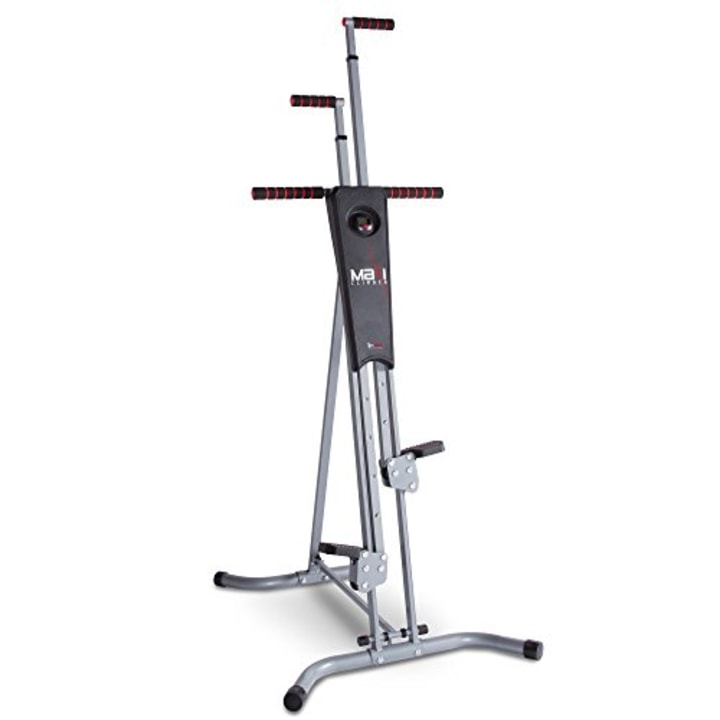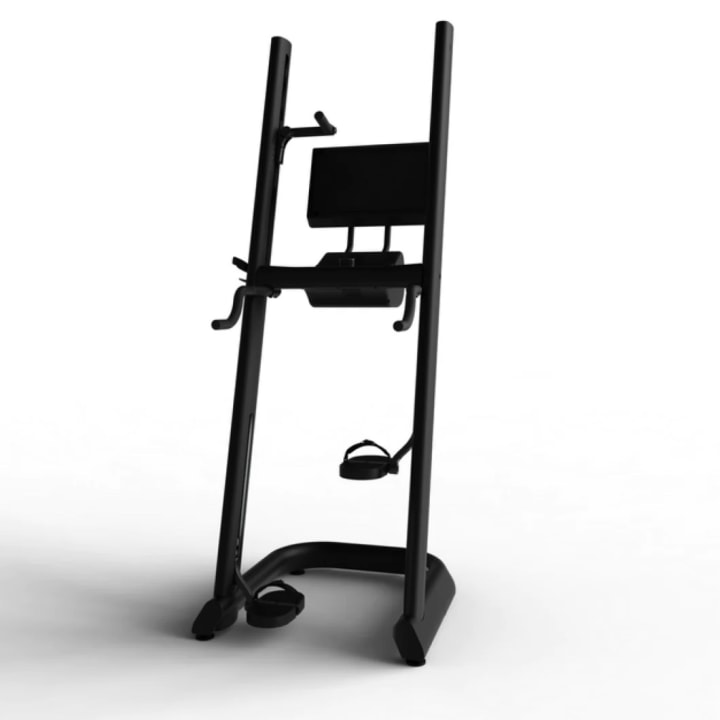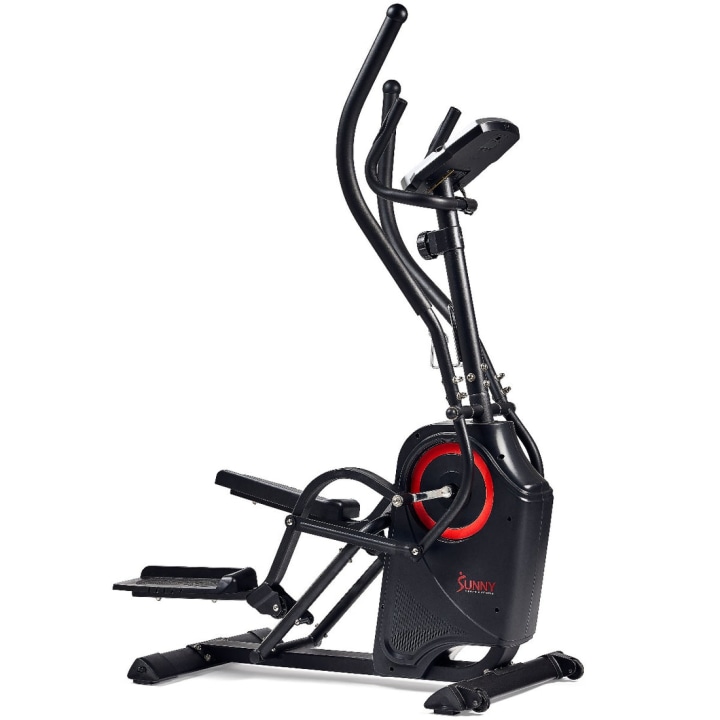Though you may not see vertical climbers scattered across home gyms as much as other popular fitness equipment like ellipticals, exercise bikes and treadmills, fitness experts say using a vertical climber is an excellent way to achieve an effective full-body workout and burn hundreds of calories in the process.
Vertical climbers are typically 7- to 8-foot-tall exercise machines that are equipped with foot pedals and height-adjustable handlebars. These machines help you pull up and down against measured resistance with the purpose of engaging your core, "as if you were climbing or scaling something," says Kyle Gonzalez, integrative health and wellness professional and head of content at nutrition and supplement company, Momentous. This exercise tool is also best used for cardio, endurance and high intensity workouts, adds Andrew Schillaci, a personal trainer at Casa Cipriani in New York City.
To help you determine whether a vertical climber is a good fit for your home gym, we spoke to fitness experts and trainers about how to best use these machines and what to look for when shopping for one. They also shared their personal recommendations with us, too.
SKIP AHEAD Best vertical climbers to shop | What are the benefits of vertical climbers?
Our top picks
- Best overall: VersaClimber Vertical Climber
- Best budget-friendly option: MaxiClimber Vertical Climber
- Best high-tech option: CLMBR Vertical Climber
How we picked the best vertical climbers
If you’re in the market for a vertical climber, our experts recommend keeping a few features in mind when shopping, including durability, size adjustability and size.
Build quality and durability: A vertical climber needs to be able to support a person moving with intensity and moderate frequency, says Ryan Hopkins, a strength coach and personal training manager at SoHo Strength Lab. Keep in mind that some of the more affordable models tend to be less durable than those with a higher price tag.
Adjustable sizing and resistance: Some vertical climbers let you adjust the height and resistance, which can benefit those who want a more intense workout. Also, “be on the lookout for foot pedal size when shopping for vertical climbers, as different brands vary,” says Jordan Rowe, a certified personal trainer and founder of NOEX Fitness in Richmond, Virginia.
Size and storage: Consider how the machine can fit in their home and the ability for it to be stored away when needed — some vertical climbers may fold or come with wheels to better store and move it around. However, even though they’re tall, “they don't take up much floor space in comparison to a rower or stair climber,” Rowe says.
Connectivity: Some vertical climbers let you sync the machine to your smartphone or other devices using Bluetooth or an app, which will allow you to access on-demand classes, track your progress and more.
Price: You can find some vertical climbers for less than $200 on Amazon, but most machines can cost upwards of $2,000, according to Rowe. Depending on your budget, how often you’ll use it and your fitness goals, some higher-end features may be worth considering, including distance, heart rate and calorie trackers, workout modes and guided training programs (most will require you to pay for a subscription service to access them).
Best vertical climbers to shop
Each of the vertical climbers we list below are recommended by our fitness experts, many of which include key features like adjustable height, a built-in display, preset programs and more.
VersaClimber Vertical Climber
If you're willing to invest in a vertical climber, Gonzalez recommends the VersaClimber because it "allows you to create or prescribe specialized workouts." The residential VersaClimber comes with 16 preset programs and a screen that displays your metrics like distance and time. You can also adjust the height and it accommodates users who are up to 6-foot-5-inches tall and weigh up to 350 pounds. While the VersaClimber is on the pricier side of the fitness equipment market, the machine itself is durable, easy to use and worth the investment, according to Schillaci. If you have a higher budget and are looking for more features, VersaClimber also offers the SM-Magnetic machine, which offers 11 adjustable resistance levels and Bluetooth connectivity.
Resistance levels: Fixed | Machine weight: 86 pounds | Maximum user weight: 350 pounds | Built-in display: Yes | Storage features: No
MaxiClimber Vertical Climber
The MaxiClimber is a quality, affordable option that’s easy to assemble and comfortable to use, according to Gonzalez. “It’s the best option for a beginner or someone looking to switch things up but not break the bank,” he says. This ergonomically-designed model comes with handle grips, an adjustable height and can accommodate users up to 240 pounds. The vertical climber also includes a step counter to track your metrics and works with a companion app to get access on-demand classes and progress tracking.
Resistance levels: Fixed | Machine weight: 33 pounds | Maximum user weight: 240 pounds | Built-in display: Yes | Storage features: Yes, folding design
CLMBR Connected 02 Vertical Climber
The CLMBR is a more "high-tech option" since it's equipped with a built-in touchscreen display and has a smartphone app you can access for on-demand classes, Gonzalez says. Though the brand's home model is more expensive than other options, Gonzalez notes that the unique design and access to instructor-led fitness classes gives it “a Peloton-like appeal.” The CLMBR can accommodate people up to 7 feet tall and has a max user weight of 350 pounds.
Resistance levels: 11 | Machine weight: 180 pounds | Maximum user weight: 350 pounds | Built-in display: Yes | Storage features: No
RELIFE Vertical Climber Exercise Machine
This RELIFE vertical climber comes recommended by Rhys Athayde, co-founder and head trainer at PHANTOM Fitness, because it’s “affordable, adjustable and lightweight, so you can move it around to different areas if you change your home gym layout.” However, Gonzalez notes that the machine’s more affordable price tag means it doesn’t come with a few key features, including adjustable resistance, reliable support and straps for your feet (which could also be a hazard). A benefit is that the machine is compact and folds to make it easier to store for home gym users, according to Gonzalez.
Resistance levels: 5 | Machine weight: 43 pounds | Maximum user weight: 260 pounds | Built-in display: No | Storage features: Yes, folding design
Sunny Health & Fitness Premium Cardio Climber Machine
This option from Sunny Health & Fitness, which makes some of our favorite affordable ellipticals and exercise bikes, can be a great option for those in a tight space since it combines a vertical climber and elliptical machine. It offers a 9-inch vertical climb, a 10-inch stride length and eight adjustable resistance levels. It comes with a mounted digital display that lets you track your time, speed, distance, estimated calories burned and more, as well as pulse sensors on the handles to measure your heart rate. It can support up to 260 pounds and has wheels for easy maneuverability.
Resistance levels: 8 | Machine weight: 95 pounds | Maximum user weight: 260 pounds | Built-in display: Yes | Storage features: No
What are the benefits of vertical climbers?
Vertical climbers combine both strength and cardio exercise, and can offer some variety to a strength and conditioning routine or work as a standalone piece, according to the experts we spoke to. The machines work by having users mimic the movement of climbing: “Using your upper and lower body muscles the entire time, it’s a low impact movement for many people with a high return on calories burned,” Rowe says. Vertical climbers are safe for everyday use, but our experts recommend mixing up any fitness routine with other forms of exercise, too.
One of the main benefits of adding a vertical climber to your training routine is that it works the sides of the body individually, according to Hopkins. “When used properly, the vertical climber addresses single-side vertical reaching and pulling, which works well with the natural movement of the body and strengthens critical areas of the shoulder girdle,” he says.
Use a vertical climber two or three times per week for the best results, Hopkins says. “You can have a high-intensity and a low-intensity day for endurance protocols, and you could even add a high-resistance day to push the individual leg strength, upper body strength and core function — it’s pretty well rounded,” he says.
However, there are a few limitations to keep in mind: “Besides the immediate risks of falling or injury if you’re not in touch with how your body moves, it requires a decent amount of space, which could be an issue for some people,” Athayde says. Gonzalez doesn’t recommend this type of machine for people with balance or coordination issues due to falling hazards, and those with metabolic or heart issues should use vertical climbers with extreme caution and seek guidance from a coach before using one.
Meet our experts
At Select, we work with experts who have specialized knowledge and authority based on relevant training and/or experience. We also take steps to ensure that all expert advice and recommendations are made independently and with no undisclosed financial conflicts of interest.
Kyle Gonzalez is an integrative health and wellness professional and currently serves as the head of content at a human performance company Momentous. He also founded The Vitality System, a platform to help people take control of their health and wellness.
Andrew Schillaci is a personal trainer at downtown Manhattan’s Casa Cipriani and a boxing instructor at Equinox in New York City.
Ryan Hopkins is a strength coach at personalized coaching company Team Wilpers and the personal training manager at SoHo Strength Lab.
Jordan Rowe is a certified personal trainer and founder of NOEX Fitness in Richmond, Virginia.
Rhys Athayde is the co-founder and head trainer at PHANTOM Fitness.
Why trust Select?
Mili Godio is an editor at Select who has written a variety of stories about fitness equipment, including dumbbells, affordable ellipticals, weighted hula hoops and more. For this article, Godio spoke to five fitness experts about the benefits of vertical climbers and gathered their recommendations for the best ones to shop.
Catch up on Select’s in-depth coverage of personal finance, tech and tools, wellness and more, and follow us on Facebook, Instagram and Twitter to stay up to date.
